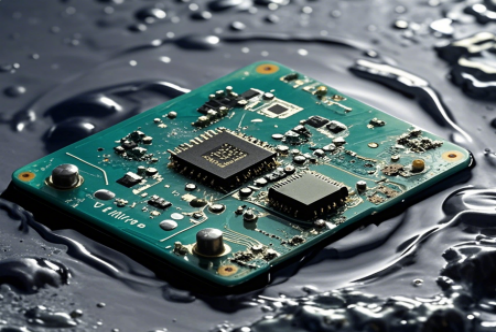| |
 |
| |
|
|
|
|
|
| |
|
What is Water Absorption in High Frequency PCB? |
|
|
|
| |
|
1.Introduction of Water Absorption |
|
|
|
| |
|
Water absorption in printed circuit boards refers to the amount of moisture that the PCB material can absorb from its environment. This property is crucial because excessive water absorption can alter the dielectric constant, lead to signal integrity issues, and increase the risk of delamination, especially in high-frequency applications. Low water absorption rates are desirable for maintaining the performance and reliability of PCBs, particularly in humid or varying temperature conditions. Materials with low water absorption help ensure consistent electrical characteristics and enhance the durability of the circuit board. |
|
|
| |
|
|
|
|
| |
|
2. The Impact of Water Absorption on Signal Integrity |
|
|
| |
|
Water absorption can lead to changes in the dielectric constant of high-frequency PCBs, affecting signal propagation speed and attenuation. These changes directly impact signal integrity, potentially resulting in transmission delays, signal distortion, and even data loss. In high-frequency applications, maintaining signal integrity is crucial, as even minor variations can significantly affect performance. |
|
|
| |
|
|
|
|
| |
|
2-1. Impact of Water Absorption on Signal Attenuation at Different Frequencies |
|
|
| |
|
Water Absorption Rate(%) |
Frequency (GHz) |
Signal Attenuation (dB) |
0.01 |
1 |
2.0 |
0.02 |
5 |
3.5 |
0.05 |
10 |
5.0 |
0.1 |
15 |
7.2 |
|
|
|
| |
|
|
|
|
| |
|
This chart illustrates how varying water absorption rates affect high-frequency signal attenuation. It is evident that increased water absorption leads to significantly higher signal attenuation, thereby impacting signal integrity. |
|
|
| |
|
|
|
|
| |
|
2-2. A damaged printed circuit board (PCB) after moisture exposure. |
|
|
| |
|
 |
|
|
| |
|
|
|
|
| |
|
3. Recommended Material: RT/duroid 6010.2LM Laminates |
|
|
| |
|
Selecting the right materials is crucial in controlling water absorption. The RT/duroid 6010.2LM/6010LM laminate has an absorption rate of just 0.01, and it features a high dielectric constant that allows for smaller circuit sizes. This low-loss material is particularly suited for operation below X-band frequencies. Moreover, its strict control over dielectric constant and thickness ensures repeatable circuit performance. |
|
|
| |
|
|
|
|
| |
|
3.1 Key specifications of RT/duroid 6010.2LM:
Material Composition: Ceramic PTFE composites
Dielectric Constant (Dk): 10.2 +/- 0.25
Loss Factor (Df): 0.0023 @ 10 GHz
Copper Cladding: Supplied clad both sides with 1/2 oz. to 2 oz./ft² (18 to 70 mm) standard and reverse treated electrodeposited copper foil.
Plate Option: Thick aluminum, brass, or copper plate on one side may be specified.
Standard Tolerance Dielectric Thicknesses: 0.010”, 0.025”, 0.050”, 0.075”, and 0.100”. |
|
|
| |
|
|
|
|
| |
|
3.2 Advantages:
High dielectric constant helps reduce circuit size
Low loss, ideal for operation below X-band frequencies
Strict control of dielectric constant and thickness ensures repeatable circuit performance
Low moisture absorption rate
High-reliability plated through-holes, suitable for multilayer boards |
|
|
| |
|
|
|
|
| |
|
3.3 Some Typical Applications: |
|
|
| |
|
Patch Antennas
Satellite Communications Systems
Power Amplifiers
Aircraft Collision Avoidance Systems
Ground Radar Warning Systems |
|
|
| |
|
|
|
|
| |
|
4. Strategies to Reduce Water Absorption in High-Frequency PCBs |
|
|
| |
|
In PCB manufacturing, appropriate process controls can effectively minimize moisture penetration. High-quality coatings and sealing materials act as barriers, reducing the risk of moisture ingress and ensuring the reliability of PCBs. Additionally, dry storage, vacuum packaging, moisture-proof design, and using desiccants also help. |
|
|
| |
|
|
|
|
| |
|
5. Economic Impact and Future Trends |
|
|
| |
|
Water absorption in high-frequency PCBs has significant implications not only for performance but also for economic factors, leading to frequent repairs and higher operational expenses. Investing in moisture management during design and manufacturing is crucial for achieving a better return on investment.
Looking ahead, future innovations will focus on developing new materials and improved processes to enhance moisture resistance, ensuring the reliability of high-frequency PCBs in various environments. |
|
|
| |
|
|
|
|
| |
|
6.Summary |
|
|
| |
|
Water absorption is a pressing technical challenge within the high-frequency PCB industry. Only by comprehensively understanding its influencing factors and implementing effective control measures can high-performance PCB products be manufactured. In the future, effective moisture management will be key to improving the performance and reliability of high-frequency PCBs. |
|
|
| |
|
|
|
|
| |
|
|
|
|
| |
|
|
|
|
| |
|
|
|
| |
|
|
|
| |
|
|
|
|
|